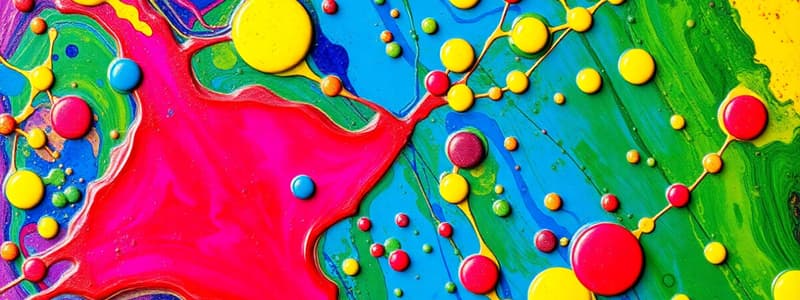Podcast
Questions and Answers
Which nanoparticle is primarily used for scratch resistance in paints?
Which nanoparticle is primarily used for scratch resistance in paints?
- Zinc oxide
- Silicon dioxide (correct)
- Cerium oxide
- Titanium dioxide
What is a key benefit of using Titanium dioxide in paint formulations?
What is a key benefit of using Titanium dioxide in paint formulations?
- UV protection (correct)
- Antimicrobial properties
- Electrical conductivity
- Corrosion resistance
Which company is known for its Nano-Ceramic Paint that improves scratch resistance?
Which company is known for its Nano-Ceramic Paint that improves scratch resistance?
- Sherwin-Williams
- PPG Industries
- Dulux
- 3M (correct)
What is one of the challenges faced in the advancement of nanotechnology-based paints?
What is one of the challenges faced in the advancement of nanotechnology-based paints?
Which application is NOT typically associated with nanotechnology-based paints?
Which application is NOT typically associated with nanotechnology-based paints?
What effect can dirt and debris accumulation have on solar panel efficiency over time?
What effect can dirt and debris accumulation have on solar panel efficiency over time?
What is the role of titanium dioxide nanoparticles in solar panel maintenance?
What is the role of titanium dioxide nanoparticles in solar panel maintenance?
What is the primary goal of the aerosol impact-driven assembly (AIDA) process?
What is the primary goal of the aerosol impact-driven assembly (AIDA) process?
What potential additional benefit does titanium dioxide provide in coatings?
What potential additional benefit does titanium dioxide provide in coatings?
Which property is NOT typically associated with paints that contain nanomaterials?
Which property is NOT typically associated with paints that contain nanomaterials?
How does the use of nanomaterials in paint benefit industries?
How does the use of nanomaterials in paint benefit industries?
Which of the following effects is NOT mentioned as a benefit of using nanomaterials in paints?
Which of the following effects is NOT mentioned as a benefit of using nanomaterials in paints?
What is one of the characteristics of nanomaterials in the paint industry?
What is one of the characteristics of nanomaterials in the paint industry?
What is the typical size range of nanoparticles used in the paint industry?
What is the typical size range of nanoparticles used in the paint industry?
Which unique property do nanoparticles provide that traditional paints do not?
Which unique property do nanoparticles provide that traditional paints do not?
What role does nanosilver powder play when mixed with paint?
What role does nanosilver powder play when mixed with paint?
What is the primary environmental benefit of the new method of synthesizing silver nanopowder developed by researchers?
What is the primary environmental benefit of the new method of synthesizing silver nanopowder developed by researchers?
Which biopolymer is used to attach silver nanoparticles to a substrate in the new synthesis method?
Which biopolymer is used to attach silver nanoparticles to a substrate in the new synthesis method?
In which field are antimicrobial coatings particularly beneficial, according to the content?
In which field are antimicrobial coatings particularly beneficial, according to the content?
What is a significant issue in the industrial world that nanotechnology in paints aims to address?
What is a significant issue in the industrial world that nanotechnology in paints aims to address?
What characteristics make nanoparticles appealing for coatings in various industries?
What characteristics make nanoparticles appealing for coatings in various industries?
What is the estimated annual global cost of fighting corrosion?
What is the estimated annual global cost of fighting corrosion?
What is graphene primarily composed of?
What is graphene primarily composed of?
What percentage improvement in scribe creep did graphene coatings achieve compared to control coatings?
What percentage improvement in scribe creep did graphene coatings achieve compared to control coatings?
What is a characteristic of the substrate used for applying graphene coatings?
What is a characteristic of the substrate used for applying graphene coatings?
What type of nanoparticles have been found effective for controlling dust and dirt?
What type of nanoparticles have been found effective for controlling dust and dirt?
What is one of the expected benefits of using TiO2-based nanocoatings on solar panels?
What is one of the expected benefits of using TiO2-based nanocoatings on solar panels?
Flashcards are hidden until you start studying
Study Notes
Nanotechnology in Paints
- Nanotechnology is altering the paint industry by improving the performance and durability of coatings.
- Nanoparticles offer unique benefits, like antimicrobial or corrosion-resistant properties.
- One example is nanosilver powder used in paints to impart antimicrobial properties.
- Nanosilver can also be used in waste management and water purification.
- Corrosion is a significant global issue costing around $2.5 trillion annually.
- Graphene, a thin carbon material, is used in anti-corrosive paints.
- In tests, graphene coatings showed a 62% improvement in corrosion resistance compared to control coatings.
- TiO2 nanoparticles, used in paints, can repel dust and dirt, especially under UV radiation.
- Swift Coat, a tech company, uses TiO2 nanoparticles to improve solar panel efficiency by reducing soiling.
- The company's AIDA technology reduces reflectivity, enhances coating porosity and thickness, leading to improved energy production.
- The TiO2 coating also provides corrosion resistance, offering another benefit.
Applications of Nanomaterials in Paints
- Nanotechnology leads to improved durability, color strength, scratch resistance, self-cleaning properties, antimicrobial properties, reduced VOCs, and enhanced UV resistance.
Common Nanoparticles in Paints
- Titanium dioxide (TiO2) is used for UV protection and whitening.
- Silicon dioxide (SiO2) enhances scratch resistance and durability.
- Zinc oxide (ZnO) provides antimicrobial and UV protection.
- Cerium oxide (CeO2) is used for corrosion resistance.
- Carbon nanotubes are used for electrical conductivity and strength.
- Nano-clay improves barrier properties and durability.
Examples of Nanotechnology-Based Paints
- 3M's Nano-Ceramic Paint improves scratch resistance and durability.
- Dulux's Nanotechnology-based Paint offers enhanced color strength and stability.
- Behr's Premium Plus ULTRA uses nanoparticles for improved durability and stain resistance.
- Sherwin-Williams' ProMar 200 uses nanotechnology for enhanced corrosion resistance and durability.
- Nissan's Self-Healing Paint uses nano-capsules that release a healing agent to repair scratches.
Applications in Industries
- Nanotechnology-based paints are used in automotive, aerospace, construction, marine, industrial coatings, and consumer goods industries.
Challenges and Future Directions
- Scaling up production and achieving cost-effectiveness are challenges.
- Toxicity and environmental concerns need careful consideration.
- Standardization and regulation are crucial for industry adoption.
- Development of new nanomaterials and applications is ongoing.
- Integration with emerging technologies like IoT and energy harvesting is a future direction.
Companies Involved in Nanotechnology-Based Paints
- 3M, AkzoNobel, BASF, DuPont, PPG Industries, and Sherwin-Williams are companies investing in nanotechnology-based paint development.
Studying That Suits You
Use AI to generate personalized quizzes and flashcards to suit your learning preferences.



